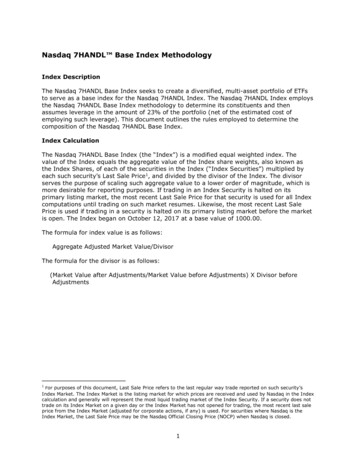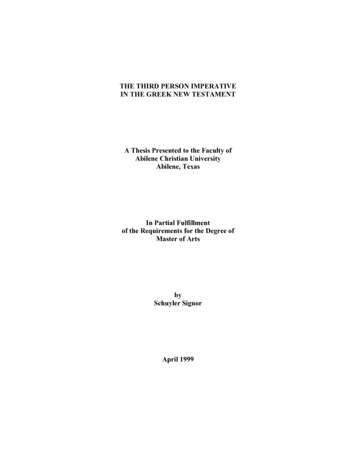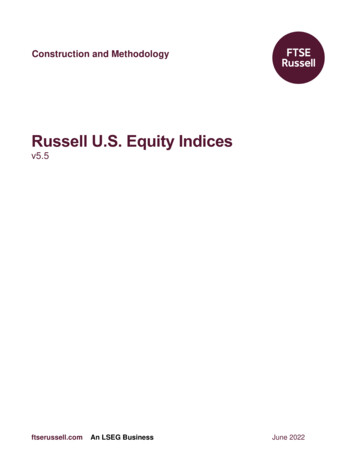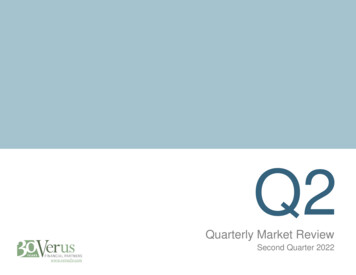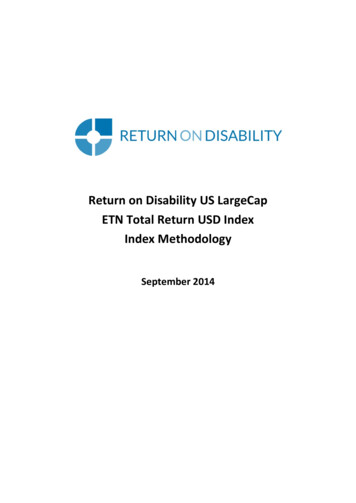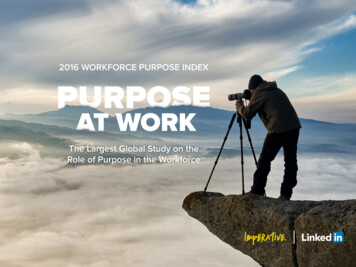
Transcription
2016 Workforce Purpose IndexThe Largest Global Study on theRole of Purpose in the Workforce
ExecutivesummaryThink about your workplace. Are your employees and coworkers setup to achieve their highest potential? Are you?Professionals spend a majority of their hours awake at work,1and yet 2 out of 3 are disengaged in their jobs. Only 30% of theU.S. workforce reports being actively involved, enthusiastic, andcommitted to their work.2 There has never been a more crucial timeto connect people with their purpose.Imagine what would happen if every person was connected topurpose at work — to a job that mattered to them, their company,and the world. Imagine how much more productive and successfulthey’d be. Think of what we could collectively accomplish.You have the power to make work more meaningful. You can createengagement and inspiration — by connecting purpose with work.Purpose at Work, 2016 Global Report LinkedIn and Imperative2
The movement is already happening.People are increasingly looking for jobs that give them personalfulfillment; and companies are seeing that purpose-orientedemployees are more productive and successful.As the economy evolves, purpose and recruiting purpose-orientedtalent will be a competitive differentiator. Companies of all sizes andindustries are realizing the power of inspiring employees with a strongsocial mission, and creating an environment that fosters purpose.“Companies that understandthe increasing emphasis ofIf you are in a position to influence hiring, talent management, orpurpose in today’s professionalemployee experience — the purpose movement cannot be ignored.landscape improve their abilityNeed proof? We did an internal analysis on the role purpose plays in ourworkforce.6 At LinkedIn, our purpose-oriented employees have higherlevels of engagement and fulfillment with their work. They outperformto attract such employees andalso their ability to retain themfor longer periods of time.” 6their peers in every indicator, including expected tenure and leadershipcompetencies like self-advocacy and comfort with senior leadership.7Read on to get the facts you need to bring purpose to your company.Reid HoffmanExecutive Chairman and co-founderLinkedInPurpose at Work, 2016 Global Report LinkedIn and Imperative3
PurposeFinding work that matters to eachperson, and connecting thosepeople to companies where theycan drive meaningful impact.4
Purpose brings profit.Connecting employees with purpose brings measurable business impact.Research from the E.Y. Beacon Institute and Harvard Business School showsthat companies that lead with purpose are more likely to be profitable.In the past three years:Perhaps even more strikingly:58%of companies with a clearly articulatedand understood purpose experienced% of non-purpose led companiesthat showed drop in revenuegrowth of 10%42%vs.% of purpose-led companiesthat showed positive growth42%85%of companies notprioritizing purpose3Purpose at Work, 2016 Global Report LinkedIn and Imperative5
Purpose, and how it drives yourtalent, has direct and tangiblebusiness results.Driven by this momentum, we set out to gather the largest dataset onpurpose in the world. Results show that purpose is an important factorin the workplace globally, with more and more employees putting apremium on jobs that allow them to connect with their purpose.The findings in this report are essential for:010203Understanding what role purpose plays inthe workforceCompanies looking to use purpose toimprove their business and talent outcomesRecruiters looking to recruit high quality,purpose-oriented talentPurpose at Work, 2016 Global Report LinkedIn and Imperative6
KeyFindingsGiven the right role and environment,LinkedIn members are ready to tapinto their purpose and reach a higherpotential at work.7
37%of LinkedIn membersglobally arepurpose-oriented73%of purpose-orientedpeople are satisfied64%vs.who are notpurpose-oriented.in their jobsThis correlation of satisfaction at work and purposeThere are some key differences when it comes to purpose-orientation was consistent in virtually every country andoriented professionals and their approach to work andindustry studied. Purpose is a motivator regardless ofopportunities. This impacts how employers shoulddifferences in region, culture, language, and occupation.approach recruiting and retaining them.Purpose at Work, 2016 Global Report LinkedIn and Imperative8
9
Purpose is directly tied to a person’s motivations for working.There are many reasons why people work. By using a set of questions, we can determine a person’sprimary reason for working — money, status, or purpose. A purpose-oriented professional prioritizeswork that matters to them, their company, and the world — over money or advancement.A new segmentation of talent, based on why we workMoneyAchievementMoney drivenPurposeMoneyAchievementStatus drivenPurposeMoneyAchievementPurposePurpose drivenBased on responses to survey questionsPurpose at Work, 2016 Global Report LinkedIn and Imperative10
Companies can lead with purpose.A company can embody purpose in a number of ways.Purpose-driven companies have a stated and measuredreason for being, a mission that all employees know.They have a culture and jobs that deliver employees thethree core elements of experiencing purpose:010203Positive impact on othersPersonal developmentDelivery of work throughstrong relationshipsPurpose at Work, 2016 Global Report LinkedIn and Imperative11
Global breakdownThere is purpose across every job and industry.37% of LinkedIn members globally are purposeJob function rangeoriented, which means that they optimize theirjob to align with work that matters to them. And,another 38% considered purpose to be equallyweighted with either money or status.54%25%in Community andSocial Servicesin AccountingAt the country level, there are people who arepurpose-oriented in every country and languagesampled. The U.S. workforce showed up nearthe middle of the pack at 40%, just over theIndustry rangeglobal average of 37%.45%in Government/Education/Nonprofit32%in Oil and EnergyPurpose at Work, 2016 Global Report LinkedIn and Imperative12
Top 5 most purpose-oriented countries:Sweden: 53%Germany: 50%Netherlands: 50%Belgium: 49%Poland: 48%5 regions with the leastpurpose-oriented workforce:United Arab Emirates: 28%40%Qatar: 28%North Africa: 28%of U.S. workforce are purpose-orientedKuwait: 26%Saudi Arabia: 23%37%Global averagePurpose at Work, 2016 Global Report LinkedIn and Imperative13
14
Purpose orientation directly impacts performance at work.In 2015, Imperative, a purpose consultancy, worked with New York University to conduct research onpurpose-oriented talent in the U.S. They defined purpose-oriented employees as people who see workas about personal fulfillment and helping other people. They compared this group to non purposeoriented people, who see work as solely a source of income or status.They found that purpose-oriented employees scored higher than the non purpose-oriented employeeson every measure studied.Highlights from the 2015 U.S. Purpose Index study:64%50%47%higher levels ofmore likely to be inmore likely to be promotersfulfillment in their workleadership positionsof their employersPlus, results didn’t find any meaningful differences in purpose orientation by race, ethnicity, or income.Companies prioritizing diversity initiatives, take note!Purpose at Work, 2016 Global Report LinkedIn and Imperative15
LinkedIn members continue to validatethe value of purpose-oriented talent.“I enjoy helping people fulfill their dreams,In response to Imperative’s 2015 Workforce Purpose Index,personally and professionally. My work as aleaders wanted answers to these critical questions:recruiter gives me purpose, and I meet — How does purpose manifest globally? Are the benefits still experienced across different cultures? How do you recruit this exceptional talent?This 2016 global study found the answers. You’ve alreadyand often become friends with — interestingand intelligent people.”– Staffing director in New Zealandseen that purpose at work is universal. We’ll cover the othertwo questions next.In response to the question:“[What I like most about my job is] that I get tochoose which projects to work on. I get to lecture“You mentioned that youwere not interested in anew job opportunity. Whatand conduct scientific research in the field I’mdo you like most about yourinterested in. And I enjoy being around colleaguescurrent job?”who are amazing professionals at what they do.”– Senior Manager of Operations, Energy in NorwayPurpose at Work, 2016 Global Report LinkedIn and Imperative16
Purpose at work benefitsare consistent globally.Purpose-orientedprofessionals39%vs.Non purpose-orientedprofessionalsAre likely to stay at theircompany for 3 years35%73%Are satisfiedwith their job64%Purpose at Work, 2016 Global Report LinkedIn and Imperative17
Whereto findpurposeorientedtalent18
Generational differencesPurpose is not only owned by millennials. Our results actually show that percentages of purpose-orientationincreased across generation groups, with baby boomers leading the way. This could potentially beconnected to broader developmental psychology theories. Erik Erikson, a German psychoanalyst, identifiedan eight-stage theory of development and identity. A shift in identity changes between the ages of 18-35and 35-65. Erickson theorized that young adults (millennials) are focused on building relationships. Whenthey reach middle age, there’s a shift to associate identity with what one is contributing to society.4% of generationgroup who arepurpose-oriented30%Millennials(18–35)38%Gen X(36–50)48%Baby Boomers(51 )Purpose at Work, 2016 Global Report LinkedIn and Imperative19
Top 5 most purpose-orientedjob functionsCommunity and Social ServicesJob typesSome job functions naturally attract nted people than others. It’sHealthcare Servicesno surprise that community and socialResearch43%41%services, entrepreneurship, education,and healthcare services attract the mostpurpose-oriented talent. However, it’simportant to note that there are purposeoriented people across all functions.The 5 least purpose-orientedjob functions25-30% of people in finance, purchasing,Operations31%and accounting consider chasingAccounting30%25%Purpose at Work, 2016 Global Report LinkedIn and Imperative20
Top 5 most cation/Non-profitNonprofit, education, and social serviceMedia and Entertainmentorganizations have the most purpose-Professional Servicesoriented staff. Many other companiesand industries are also competingin the space. Media, entertainment,45%43%41%Healthcare and Pharmaceutical40%Staffing38%consulting, healthcare, staffing, andtechnology (not shown) industries havehigh percentages of purpose-orientedThe 5 least purpose-orientedtalent. If your company is in one of theseindustriesindustries, paying attention to retainingand continuing to hire purpose-orientedemployees is critical.Financial Services and Insurance33%Architecture and Engineering33%Manufacturing and Industrial33%Retail and Consumer Products33%Oil and Energy32%Purpose at Work, 2016 Global Report LinkedIn and Imperative21
Behavior and interestsPurpose-oriented people are still the minority. As their valuebecomes better known, there will be more and more competitionfor this segment of the workforce.What you need to know about recruiting purpose-oriented people: Engage in recruiting passive candidates. Purpose-orientedemployees are more likely to be passive: 69% vs. 61% who arenot purpose-oriented. Focus more on your organization’s mission, vision,products, and services — less on perks and benefits.Top 3 factors that entice purpose-orientedpeople to accept a new job:010203Culture and valuesMission and visionProducts and servicesPurpose at Work, 2016 Global Report LinkedIn and Imperative22
Purpose taps auniversal need. Itserves as a motivatordespite culturaldifferences – unitingeveryone to contributeto something bigger.323
Purpose-driven companies get more engagement on LinkedIn.3.5x33%117%more company followersper employeebetter InMailacceptance ratemore LinkedInCompany Page viewsper employeeBeyond that, LinkedIn members want jobs that offer a sense of purpose. 74% of members place a high valueon finding work that delivers on a sense of purpose.Purpose at Work, 2016 Global Report LinkedIn and Imperative24
Industries where connecting employeesto purpose at work makes the biggestimpact on job satisfaction:Make purpose work for you.StaffingWe found that all industries and functions had purpose-oriented70%employees. However, some are able to attract and empower53%them more effectively than others.This underscores the need toattract and support purpose-oriented workers.Healthcare and Pharmaceutical68%57%Other contributing variables that affecthow employees experience %AutonomyProfessional Services63%Power and influenceIncome and recognition854%Financial Services and Insurance66%57%Purpose-oriented talentNon purpose-oriented talentPurpose at Work, 2016 Global Report LinkedIn and Imperative25
3 ways to apply these findings toyour talent strategy:01Talent BrandIncorporate purpose into your branding efforts to drive continual candidate awareness,and attract the candidates you want.02RecruitmentInfuse your organization’s purpose throughout the recruitment process. Seek outpurpose-oriented talent, start conversations with your organization’s mission and values,and ask questions like “what motivates you?” in your interview process. Look beyondskill match, and hire candidates to jobs that connect with their sense of purpose.03Employee retentionUnderstand what drives your employees, and how they experience purpose. Make surethey have autonomy, influence, fair compensation, and the resources needed to do theirjob. Clearly define and communicate company values, culture, and mission.Purpose at Work, 2016 Global Report LinkedIn and Imperative26
ConclusionPurpose isn’t genetic — we aren’t born with a predeterminedwork orientation. The variation in purpose orientation bycountry and culture show that nurture and upbringing may befactors. Given the right environment and coaching, managers,mentors, and talent acquisition leaders can help foster asense of purpose in employees.Connecting your employees and applicants to jobs that bringout their sense of purpose will only benefit your company.Employees that are more satisfied and fulfilled are higherperformers, more productive, and likely to stay longer.Purpose at Work, 2016 Global Report LinkedIn and Imperative27
MethodologyLinkedIn and Imperative partnered to answer these questions in aglobal survey of 26,151 LinkedIn members in 40 different countriesand 16 different languages between January and February of 2016.The majority were employed full-time orThe results of this analysis representpart-time when they took the survey.the world as seen through the lens ofWe asked about their attitudes,LinkedIn data. As such, it is influencedopinions, and behaviors about variousby how members choose to useaspects of job seeking. The theoreticalthe site, which can vary based onmargin of error for this survey /- 0.61%professional, social, and regional culture.at the 95% confidence interval and ishigher for subgroups.Purpose at Work, 2016 Global Report LinkedIn and Imperative28
To identify purpose orientation in the sample, we asked respondents to rate how similar they were tothree paragraphs describing people with different work orientations: Money, Status, or Purpose.Respondents who clearly identified with the purpose-orientation paragraph the strongest were deemed to bepurpose-oriented. They are considered Purpose-Inclined if they have a high scored tied between purpose andanother orientation. These categories have been developed and refined based on previous academic researchconducted by Amy Wrzesniewski, Barry Schwartz and Adam Grant, among others, and has reliably produceddistinct categories in which people can easily see themselves.MoneyStatusPurposeA believes that work is an unavoidableB believes that work gives B the chance to beC believes that work has the potential to be anecessity. His main reason for working is tosuccessful and prove himself. B is strategicvaluable and meaningful part of C’s life, even ifhave enough money to support himself andand works hard to perform well in ways thatit is occasionally stressful or difficult. C enjoyshis life outside of work. If A won the lottery, hewill advance B’s career. B is willing to investtalking and thinking about C’s work, as wellwould stop working and enjoy life. He lives forhis time on tasks that B finds boring in orderas building relationships with C’s coworkers.the weekends and is annoyed when his workto move ahead more quickly. B hopes to be inC feels like C’s work life is mostly of C’s ownintrudes on his personal life. He does not likea higher level position in the next few years.making. C has made sacrifices in order toto talk about work with others and most ofdo the work C loves while having a positivehis social relationships are not connected toimpact on others and the world.work. A doesn’t have very much control overhis work life and would probably choose to dosomething else if given the opportunity.Purpose at Work, 2016 Global Report LinkedIn and Imperative29
Authors & contributorsAaron HurstLauren VestyCEO, ImperativeMarketing Manager, LinkedInAdam PearceAllison SchnidmanResearcher, ImperativeStrategic Research Consultant, LinkedInCammie EricksonMeg GarlinghouseManager, LinkedIn for GoodSenior Director, LinkedIn for GoodScott ParishAndrea PavelaSenior Product Marketing Manager, LinkedInResearch Analyst, LinkedInPurpose at Work, 2016 Global Report LinkedIn and Imperative30
References1. United States Bureau of Labor, “American Time Use Survey.”29 Oct. 2015Amabile, T., & Kramer, S. (2011). The progress principle: Using small winsto ignite joy, engagement, and creativity at work. Boston, Mass.: HarvardBusiness Review Press.2. Adkins, A. (2015). Majority of U.S. Employees Not Engaged DespiteGains in 2014. Gallup.3. Keller, V. (2015). The Business Case for Purpose. Harvard BusinessReview. Boston, Mass.: Harvard Business School Publishing.4. Learning Theories. “Erikson’s Stages of Development.” Web.5. Imperative, New York University. (2015). 2015 WorkforcePurpose Index.6. Hoffman, R. (2015). The Power of Purpose at Work. LinkedIn.7. Hurst, A. (2015). Scaling with Purpose at LinkedIn. Imperative.8. Garton, E. Mankins, M. (2015). Engaging Your Employees is Good,but Don’t Stop There. Harvard Business Review.Dekas, H., Baker, Wayne. (2014), Adolescent socialization and thedevelopment of adult work orientations, in Henrich R. Greve , Marc-david L.Seidel (ed.) Adolescent Experiences and Adult Work Outcomes: Connectionsand Causes (Research in the Sociology of Work, Volume 25) Emerald GroupPublishing Limited, pp.51 - 84.Eskreis-Winkler, L., Shulman, E., Beal, S., & Duckworth, A. (2014). The griteffect: Predicting retention in the military, the workplace, school and marriage.Frontiers in Psychology. doi:10.3389/fpsyg.2014.00036Grant, A. (2007). Relational Job Design and the Motivation to Make aProsocial Difference. Academy of Management Review, 32(2), 393-417.Grant, A. (2013). Give and take: A revolutionary approach to success. NewYork, N.Y.: Viking.Steger, M., Dik, B., & Duffy, R. (2012). Measuring Meaningful Work: The Workand Meaning Inventory (WAMI). Journal of Career Assessment, 322-337.Wrzesniewski, A., McCauly, C., Rozin, P., & Schwartz, B. (1997). Jobs,Careers, and Callings: People’s Relations to Their Work. Journal of Researchin Personality, 31, 21-33.Purpose at Work, 2016 Global Report LinkedIn and Imperative31
Attract, recruit, and empower the best people for your business with LinkedIn.Get access to quality candidates — active and passive, external and internal —on the world’s largest professional network of 433M candidates.For more information, visit business.linkedin.com.Imperative is a social benefit corporation driven to empower people torealize their potential by convening and empowering the next generationof leaders. Our purpose assessment platform includes the first set oftools and resources to uncover, express and connect peoplearound purpose in their work each day.
In 2015, Imperative, a purpose consultancy, worked with New York University to conduct research on purpose-oriented talent in the U.S. They defined purpose-oriented employees as people who see work as about personal fulfillment and helping other people. They compared this group to non purpose-
